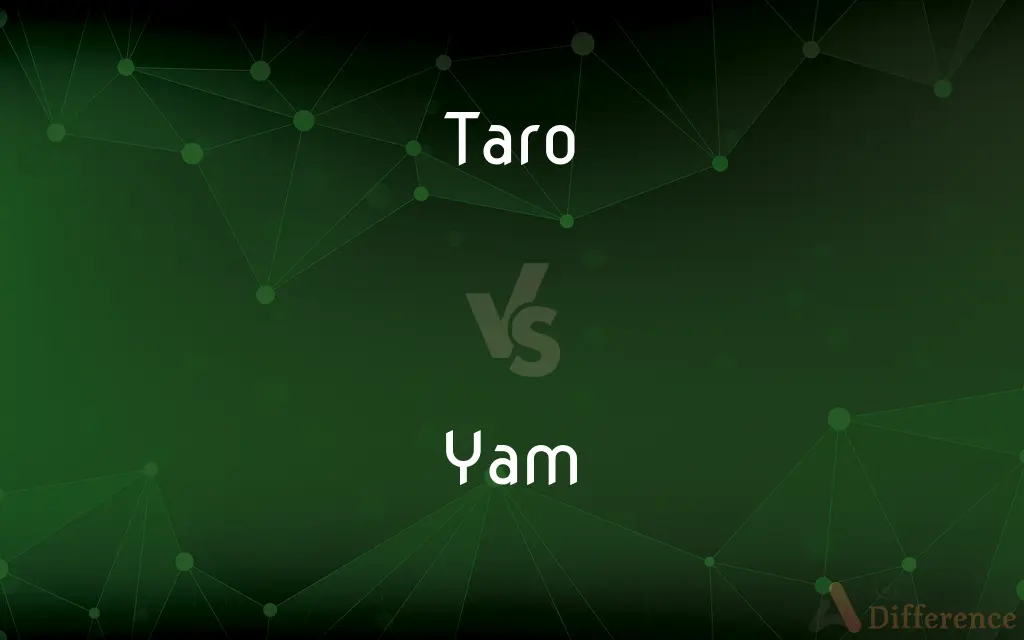Taro vs. Yam — What's the Difference?
Edited by Tayyaba Rehman — By Fiza Rafique — Updated on November 3, 2023
Taro is a starchy root vegetable with a fibrous texture, often used in Asian and Pacific cuisines, while yam is a sweeter tuber, widely used in African and American dishes.

Difference Between Taro and Yam
Table of Contents
ADVERTISEMENT
Key Differences
Taro is a tropical plant known for its edible corms, while yam is a term used for several types of tubers from different plants. Taro corms are smaller and have a nuttier flavor compared to the sweeter, larger yams.
Taro is characterized by its rough, fibrous skin, which is usually brown and needs to be peeled before eating. Yams, which can range in color from white to orange, often have a smoother skin and can be quite large.
Culinary uses of taro include poi in Hawaiian cuisine, taro chips, and taro root in stews. Yams are commonly found in dishes like candied yams, yam pie, and are a staple in many West African nations.
In terms of nutrition, taro is a good source of fiber and vitamins E and B6. Yams are high in vitamins C and B1 and provide a good source of potassium and manganese.
Both taro and yam are versatile ingredients in global cuisines but are prepared differently due to their distinct textures and flavors, with taro being more common in Asian dishes and yams in African and American soul food.
ADVERTISEMENT
Comparison Chart
Botanical Source
Colocasia esculenta
Genus Dioscorea
Skin Texture
Rough and fibrous
Smooth, sometimes bark-like
Flavor Profile
Nutty and earthy
Sweet, can vary by variety
Size and Shape
Generally small and round
Larger, cylindrical, can be very long
Cultural Association
Asian and Pacific cuisines
African and American cuisines
Compare with Definitions
Taro
A tropical root vegetable used commonly in Asian cuisine.
I made a delicious taro bubble tea.
Yam
Yams are different from sweet potatoes, though often confused.
The market had both yams and sweet potatoes for sale.
Taro
A starchy corm that is purple, white, or pink inside.
We served mashed taro at dinner.
Yam
In the U.S., the term 'yam' often incorrectly labels orange-fleshed sweet potatoes.
I picked up some yams for Thanksgiving dinner.
Taro
The term taro can also refer to the entire plant, not just the root.
The taro in our garden has grown exceptionally well this year.
Yam
The word yam is derived from the African word "nyami," which means "to eat."
Yams are a crucial part of the diet in many parts of West Africa.
Taro
Used to make poi in Hawaiian culture.
Poi is made by mashing cooked taro.
Yam
Any of numerous chiefly tropical vines of the genus Dioscorea, many of which have edible tuberous roots.
Taro
Taro refers to the plant Colocasia esculenta.
Taro leaves are also edible when cooked.
Yam
The starchy root of any of these plants, used in the tropics as food.
Taro
Colocasia esculenta is a tropical plant grown primarily for its edible corms, a root vegetable most commonly known as taro (), kalo, dasheen, madhumbe, marope, magogoya, patra or godere (see §Names and etymology for an extensive list). It is the most widely cultivated species of several plants in the family Araceae that are used as vegetables for their corms, leaves, and petioles.
Yam
See sweet potato.
Taro
A tropical Asian plant of the arum family which has edible starchy corms and edible fleshy leaves, especially a variety with a large central corm grown as a staple in the Pacific.
Yam
Any climbing vine of the genus Dioscorea in the Eastern and Western hemispheres, usually cultivated.
Taro
A widely cultivated tropical Asian aroid plant (Colocasia esculenta) having broad peltate leaves and large starchy edible corms.
Yam
The edible, starchy, tuberous root of that plant, a tropical staple food.
Taro
The corm of this plant. In both senses also called cocoyam.
Yam
(US) A sweet potato; a tuber from the species Ipomoea batatas.
Taro
Colocasia esculenta, raised as a food primarily for its corm, which distantly resembles potato.
Yam
(Scotland) Potato.
Taro
Any of several other species with similar corms and growth habit in Colocasia, Alocasia etc.
Yam
(NZ) A oca; a tuber from the species Oxalis tuberosa.
Taro
Food from a taro plant.
Yam
Taro.
Taro
A name for several aroid plants (Colocasia antiquorum, var. esculenta, Colocasia macrorhiza, etc.), and their rootstocks. They have large ovate-sagittate leaves and large fleshy tuberous rootstocks, which are cooked and used for food in tropical countries.
Yam
An orange-brown colour, like the flesh of the yam. en
Taro
Edible starchy tuberous root of taro plants
Yam
A large, esculent, farinaceous tuber of various climbing plants of the genus Dioscorea; also, the plants themselves. Mostly natives of warm climates. The plants have netted-veined, petioled leaves, and pods with three broad wings. The commonest species is Dioscorea sativa, but several others are cultivated.
Taro
Herb of the Pacific islands grown throughout the tropics for its edible root and in temperate areas as an ornamental for its large glossy leaves
Yam
Any one of several cultural varieties of the sweet potato.
Taro
Tropical starchy tuberous root
Yam
Edible tuber of any of several yams
Yam
Any of a number of tropical vines of the genus Dioscorea many having edible tuberous roots
Yam
Sweet potato with deep orange flesh that remains moist when baked
Yam
Edible tuberous root of various yam plants of the genus Dioscorea grown in the tropics world-wide for food
Yam
A tuberous root, often with a sweet flavor, widely used in African cuisines.
I prefer my yam baked with a sprinkle of cinnamon.
Yam
They come in a variety of colors including white, orange, and purple.
She added purple yam to her smoothie for color.
Common Curiosities
Can taro be eaten raw?
Taro should not be eaten raw due to the presence of calcium oxalate.
Are yams and sweet potatoes interchangeable?
While often confused, they are different and not always interchangeable in recipes.
Are taro and yam the same?
No, they are distinct tubers from different plant species.
Are yams only sweet?
Yams tend to be sweet but the sweetness can vary by type.
What is a yam?
A yam is a sweet tuber from the genus Dioscorea.
Is taro used in desserts?
Yes, taro is used in many desserts, especially in Asian cuisine.
What is taro?
Taro is a starchy root vegetable from the plant Colocasia esculenta.
Is taro skin edible?
Taro skin is typically not eaten and should be peeled before cooking.
Do both taro and yam have nutritional benefits?
Yes, both are nutritious, offering vitamins, minerals, and fiber.
Share Your Discovery

Previous Comparison
Furnace vs. Heater
Next Comparison
Bowl vs. CupAuthor Spotlight
Written by
Fiza RafiqueFiza Rafique is a skilled content writer at AskDifference.com, where she meticulously refines and enhances written pieces. Drawing from her vast editorial expertise, Fiza ensures clarity, accuracy, and precision in every article. Passionate about language, she continually seeks to elevate the quality of content for readers worldwide.
Edited by
Tayyaba RehmanTayyaba Rehman is a distinguished writer, currently serving as a primary contributor to askdifference.com. As a researcher in semantics and etymology, Tayyaba's passion for the complexity of languages and their distinctions has found a perfect home on the platform. Tayyaba delves into the intricacies of language, distinguishing between commonly confused words and phrases, thereby providing clarity for readers worldwide.














































